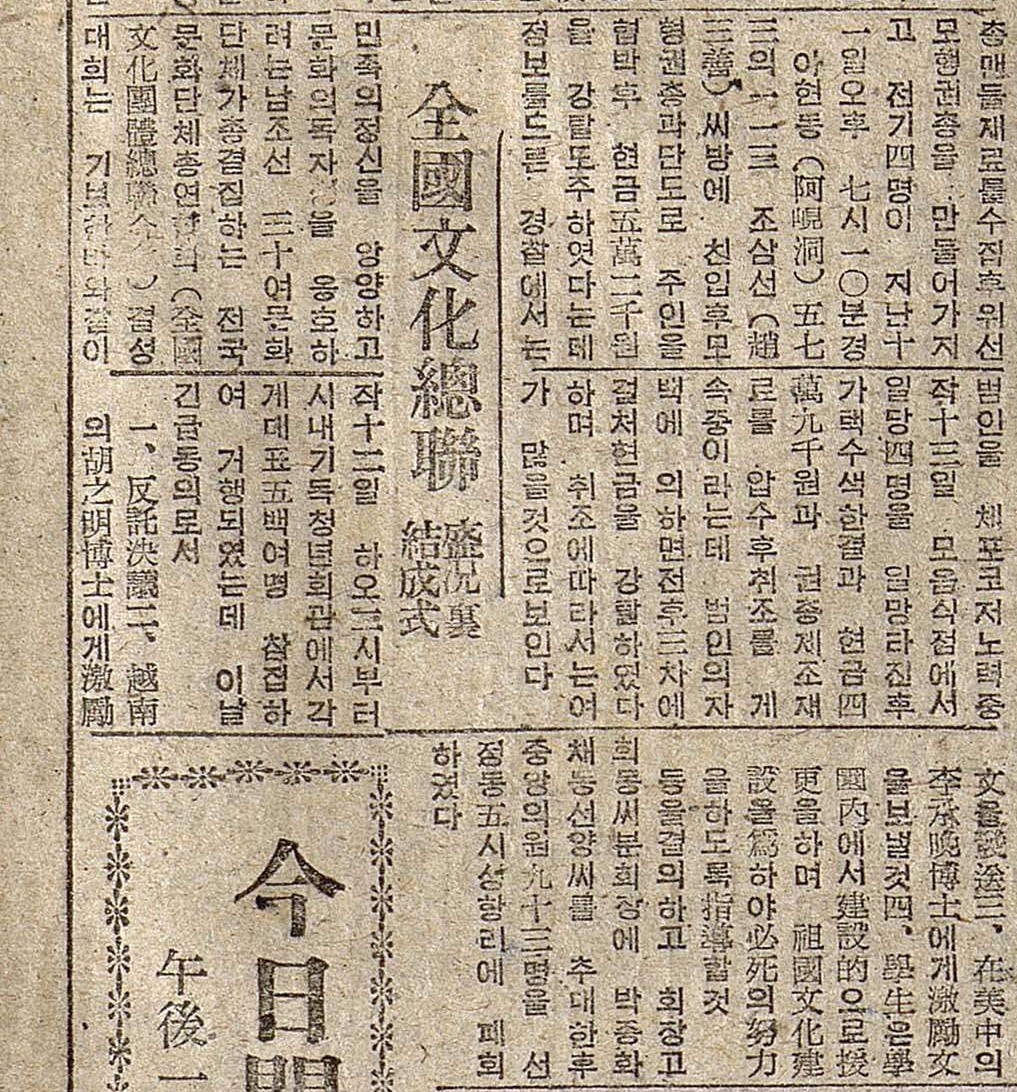
Minjok Munhwa (National Culture) No.1, October 1949, MMCA Art Research Center Collection
Korean Federation of Cultural Organizations
* Source: Multilingual Glossary of Korean Art. Korea Arts Management Service
Related
-
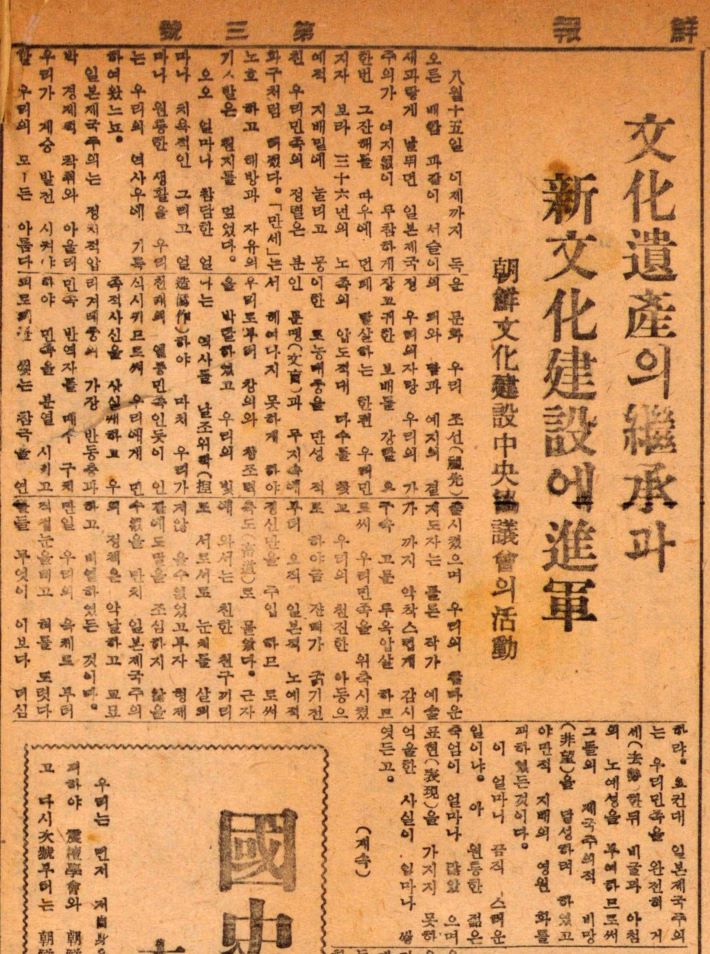
Central Committee for the Construction of Korean Culture
A progressive cultural activist organization established on 18 August 1945, under the leadership of Yim Hwa, Lee Taejun, Kim Namchun, and Lee Wonjo. The concern of the Central Committee for the Construction of Korean Culture (Joseon munhwa geonseol jungang hyeopuihoe) was cultural liberation, cultural development, and national reunification after the divisive period of colonialism. The purpose of this association was to build an independent national culture. On 17 September 1945, dissatisfaction with the ambiguous class-based tendencies of the Central Committee for the Construction of Korean Culture (Joseon munhwa geonseol jungang hyeopuihoe) led Han Seol-a, Lee Giyeong, and Yun Gijeong to leave the group and organize the Korean Artist Proletarian Federation. On the 13th of December that same year, the Communist Party of Korea demanded that both the Central Committee for the Construction of Korean Culture (Joseon munhwa geonseol jungang hyeopuihoe) and the Korean Artist Proletarian Federation (Joseon peurolletaria yesul dongmaeng) merge, and the two organizations merged into the Federation of Korean Writers (Joseon munhakga dongmaeng) on 8 February 1946.
-
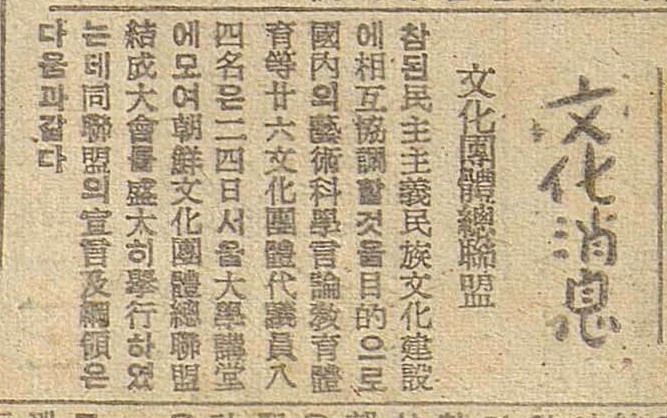
Korean Federation of Cultural Organizations
A cultural organization formed in 24 February 1946, also known as Munryeon. The alliance represented a total of 25 cultural organizations established after independence. Its membership comprised a total of 13 scholarly organizations, including the Joseon Haksulwon, Joseon Scientists Federation, Joseon Institute of Industry and Medicine, Joseon Institute of Legal Scholars, Joseon Linguistics Institute, and Joseon Institute of Women Scientists; a total of 9 art organizations, including the Korean Writers Federation, Joseon Theater Federation, Joseon Music Federation, Joseon Film Federation, and the Joseon Art Federation; and the Joseon Journalists Association, Joseon Educators Association, and Joseon Sports Association. The Munryeon's concerns included encouraging the rightful succession of national culture, a critical consumption of world culture, the importation and research of advanced scientific method, the development of new theories, democratic education of the masses, scientific enlightenment, and the exclusion of unscientific and undemocratic cultural tendencies. The group expressed support for the National Democratic Front. As such, right-wing members left the group and formed the Federation of Artistic & Cultural Organization.
-

Korean Federation of Cultural Organizations
A right-wing association founded on Feburary 12th, 1947, to challenge leftist groups, such as the Central Committee for the Construction of Korean Culture [Joseon munhwa geonseol jungang hyeopuihoe], the Korean Federation of Cultural Organizations [Joseon munhwa danche chong yeonmaeng], and thek Korean Young Literati Association [Joseon cheongnyeon munhakga hyeophoe]. Its nickname was ‘Munchong.’ The Organization opposed trusteeship, supported national culture, and was anti-communist. Participating groups included the Korean Art Association [Joseon misul hyeophoe], the Association of Joseon Writers [Jeon joseon munpilga hyeophoe], Theater Art Association, Joseon Film and Screenplay Writer Association, Joseon Young Literati Association, Dangu Art Academy [Dangu misulwon], Foreign Literature Study Group, Korea-China Cultural Association, Joseon Documentary Photography Cultural History, Chungang Cultural Association, Joseon Educational Art Association, Goryeo Music Association, the National Wind-instrument Music Association, The Center for Historical Truth and Justice, the Joseon Calligraphy Association, the Biology Society, Danshimhoe, the Joseon Education Society, the Joseon Sports Society, the Construction Technology Group, the Korean Commercial Art Association [Joseon sangeop misul hyeophoe], the Joseon Art Photography Association [Joseon sajin yesul yeonguhoe], the International Culture Association, the Joseon Photography Association, and the Joseon Astronomy Society. The first president was Ko Huidong, vice-presidents were Park Jong-hwa and Chae Dong-sun, and the manager was Lee Heon-goo. Their magazine Minjok Munhwa (National Culture) was published in 1949. The group was actively involved in many activities, (such as constructing Munchonggugukdae) until it was disbanded due to the May 16 military coup in 1961.
Find More
-
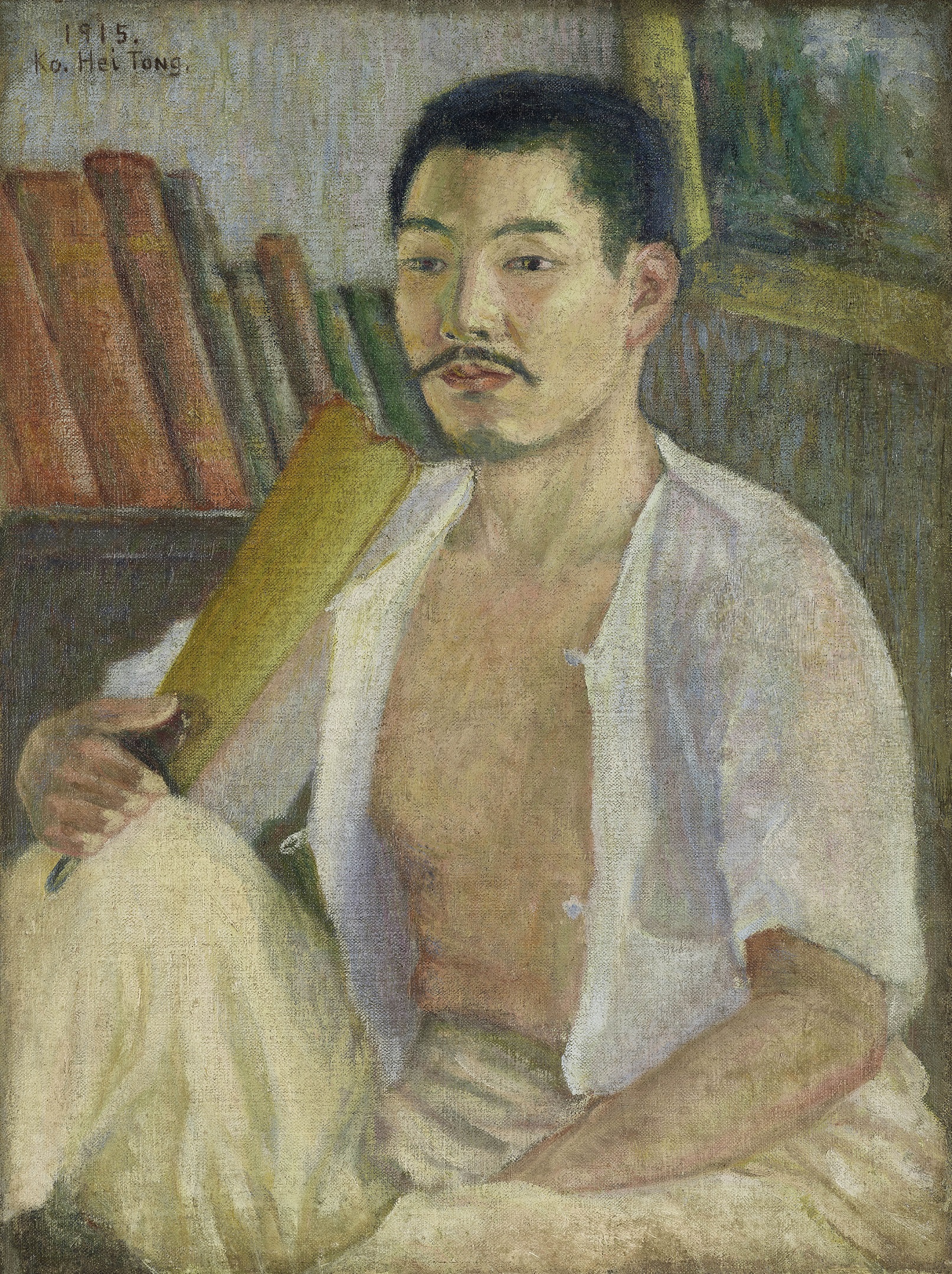
Ko Huidong
Ko Huidong (1886-1965, pen name Chungok) was born in Seoul and graduated from Hanseong French Language School. He worked as an interpreter and was appointed as a government official of the Korean empire. In 1907, he began to learn painting from An Jungsik and Cho Seokjin. He visited Japan to study art in 1909 and later attended Tokyo School of Fine Arts where he studied oil painting. The advent of Japanese colonization in 1910 caused him to lose his position as a government official and he became a student. He graduated in 1915. A Self-portrait with Jungjakwan (traditional Korean hat for government officials) reflected his self-consciousness of his former role as a government official of the Korean empire. His oil paintings, such as A Self-portrait with Durumagi (traditional Korean overcoat) or A Self-portrait Holding a Fan, are currently owned by the MMCA in Gwacheon. In the 1920s, he stopped creating Western paintings due to the lack of understanding of people around him. After this period, he focused on Eastern paintings depicting subjects such as Geumgangsan Mountain or other nativist landscape themes. He organized the Calligraphy and Painting Association [Seohwa hyeophoe] with An Jungsik, Cho Seokjin, and Lee Doyoung and worked as a secretary of that Association's exhibitions. He was acquainted with numerous other artists and he actively participated in political activism in the modern painter’s circle in Korea. Following the example of his father Ko Yeongcheol, a member of Yukgyo Poetic Gathering [Yukgyo sisa], he also interacted with other artists, such as Oh Sechang. He helped to organise artists as a chair of the Great Korean Art Association [Daehan misul hyeophoe] and later was appointed as a senator. In 1954, He was selected as the first chairman of the National Academy of Arts. His universal significance can be seen in his crucial contribution to the establishment of the first association of Western painting artists and modern artists in Korea.
-
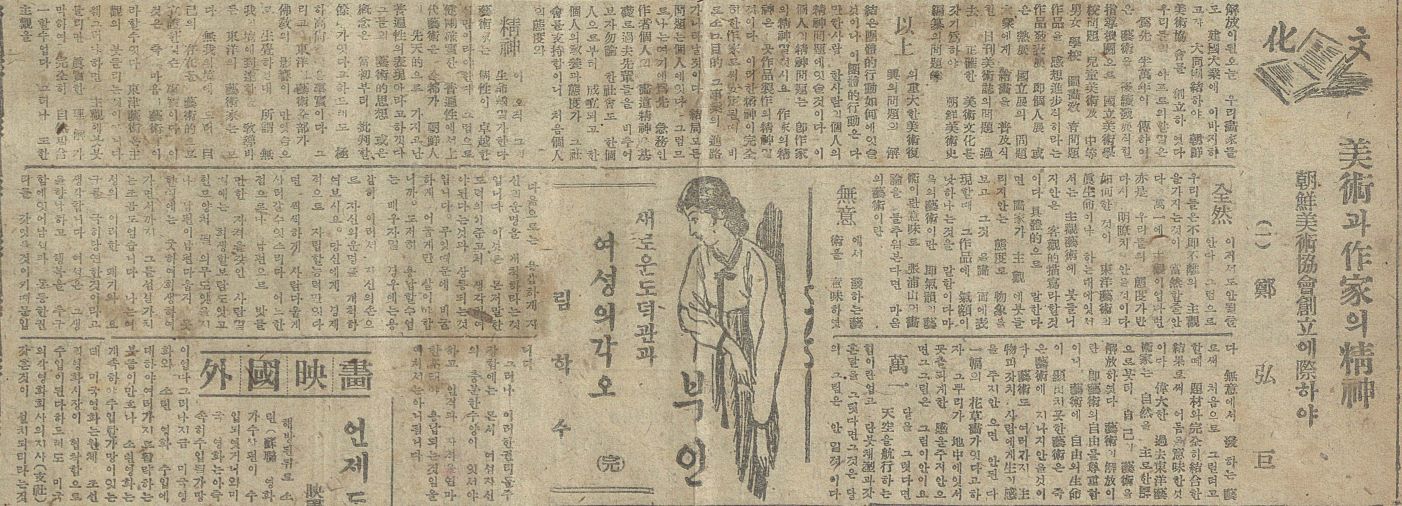
Korean Art Association
An organization established in 1945 under the leadership of Ko Huidong after the Headquarters for the Korean Art Construction Headquarters (Joseon misul geonseol bonbu), the largest art organization of the time, disbanded. Criticizing the political activism of the Korean Art Construction Headquarters, the Korean Artists Association avowed political neutrality Ko Huidong was the president of the association, and famous artists of the time such as Lee Chongwoo, Kim Yongjun, Kim Jukyung, No Soohyeon, and Gilbert Pha Yim all participated in the association. The association claimed to be the successor of the Society of Painters and Calligraphers, which was active from the late 1910s to the 1930s. The association planned the establishment of art schools, the publication of books on art history, the holding of exhibitions, and the publication of art magazines. Contrary to its avowed political neutrality, however, Ko Huidong, who held right-wing beliefs, continued with his pro-government activism, and numerous members who opposed this left the association to form the Korean Art Alliance (Joseon misul dongmaeng) in 1946.
-

Korean Commercial Art Association
A commercial art association established in March 1946. Kim Junghyun was appointed as the president and administrator; Yang Jae-hyeon as director; and Oh Ju-hwan, Yang Gyu-hui, and Jo Bong-hyeon as assistant administrators. Its doctrine consisted of the following points: "[1] We will strengthen our artistic spirit and achieve significant progress in our national culture. [2] We, as commercial artists, will contribute to the grand project of the formation of a new Joseon [Korea]." In May, the association held their first group exhibition at the Hwasin Gallery. And again in December, the association held a second group exhibition at the same gallery. Kim Junghyun, the president, was a talented artist who had continuously submitted his artworks to the Joseon Art Exhibition during the colonial era, and after independence he continued to serve as a panel judge for the crafts segment of the National Art Exhibition of Korea.






